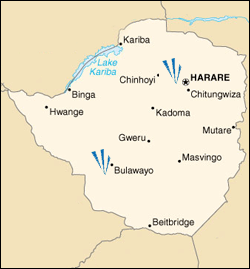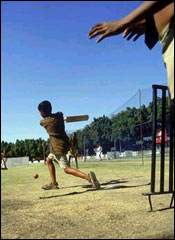
Of 'Stone Dwelling' and their cricket
Mohandas Menon
The Republic of Zimbabwe was formerly called Southern Rhodesia from 1911 to 1964 and then Rhodesia from 1964 to 1979. Finally, from 1980, it got its present name - Zimbabwe.
It landlocks the country of southern Africa and is bordered on the north by Zambia, on the northeast and east by Mozambique, on the south by South Africa, and on the southwest and west by Botswana, and its extreme western corner touches Namibia.
 In Bantu, a local language, Zimbabwe means "Stone Dwelling" because of an extensive stone ruin in southeastern Africa, situated southeast of Nyanda (formerly Fort Victoria). In fact, there are many stone ruins scattered across the countries of Zimbabwe and Mozambique. Its oldest parts date from the 8th century AD, although the site had been occupied for about 600 years before that.
In Bantu, a local language, Zimbabwe means "Stone Dwelling" because of an extensive stone ruin in southeastern Africa, situated southeast of Nyanda (formerly Fort Victoria). In fact, there are many stone ruins scattered across the countries of Zimbabwe and Mozambique. Its oldest parts date from the 8th century AD, although the site had been occupied for about 600 years before that.
In the 11th to 15th century it was a centre (possibly religious) of a great inland empire ruled by the people. They smelted gold there and traded it on the shores of the Indian Ocean for glass beads and porcelain from China. Copper coins and birds carved in soapstone were also among their treasures. The centre remained in use at least until the 17th century. The rediscovery of the ruins in 1867 attracted much archaeological research.
The country's cricket history is closely entwined with that of South Africa. Since 1890 the country was administered by the British South Africa Company. British entrepreneur Sir Cecil Rhodes, who, as the prime minister of the Cape Colony in South Africa, secured British extension in the territory that was to bear his name.
In fact, cricket was first introduced by the employees of his company and the first cricket match took place at Fort Salisbury in 1891, between the Police and the Civilians.
Meanwhile, the first English cricket side to visit the country was Lord Hawke's team of 1898-99. It was during this time the Rhodesian Cricket Union was formed. In fact, a well-known South African cricket patron JD Logan, asked Lord Hawke to purchase a cup, which could be used as trophy by competing cricket clubs within Rhodesia. However, it was not until 1903-04 that a proper tournament was organised, with Matabeleland as the first winners. Despite all these efforts cricket only flourished in and around Salisbury (now Harare) after the second World War.
In April 1980, following multi-party elections, Rhodesia became formally independent as the Republic of Zimbabwe. The capital of Zimbabwe is Harare (formerly Salisbury) and is located in the district of Mashonaland. It is Zimbabwe's largest city, and is its main commercial and cultural center. The city has a population of over 1.5 million. The country's second largest city, and the main centre of Matabeleland is Bulawayo, which has a population of less than a million. It is an important manufacturing centre and has a railway junction.
Zimbabwe were granted Test status by the ICC in July 1992 and played its first Test match against India at Harare in October 1992 - the match was drawn!
 Although, Zimbabwe (then Rhodesia) had appeared as a first-class team in the South African Currie Cup from 1905 onwards, it was only from 1993-94 season, the Zimbabwe Cricket Union decided to organise its own domestic first-class tournament. It was aptly called the Logan Cup, after JD Logan, the South African who was instrumental in setting up some organised cricket in the country at the turn of the last century. The participating teams then were: Mashonaland, Mashonaland Under-24, Mashonaland Country Districts and Matabeleland. However in 1995-96 the Zimbabwe Cricket Union decided to restrict the competition among just two teams Mashonaland and Matabeleland, since most of the players were not available to play in domestic matches.
Although, Zimbabwe (then Rhodesia) had appeared as a first-class team in the South African Currie Cup from 1905 onwards, it was only from 1993-94 season, the Zimbabwe Cricket Union decided to organise its own domestic first-class tournament. It was aptly called the Logan Cup, after JD Logan, the South African who was instrumental in setting up some organised cricket in the country at the turn of the last century. The participating teams then were: Mashonaland, Mashonaland Under-24, Mashonaland Country Districts and Matabeleland. However in 1995-96 the Zimbabwe Cricket Union decided to restrict the competition among just two teams Mashonaland and Matabeleland, since most of the players were not available to play in domestic matches.
The major cricket grounds are located at Harare and Bulawayo. The Harare Sports Club Ground, formerly the Salisbury Sports Club is situated in the district of the Mashonaland and has been in existence since 1909, when a first-class match was played there. As on date, over 100 first-class matches have been played at this venue. Zimbabwe had played its first ever Test match at this venue from October 18-22, 1992. Since then in all 17 Test matches have been played here. The venue has also hosted 27 limited-over internationals so far.
The other cricket ground is situated at Bulawayo, which has the distinction of hosting international matches at two separate grounds - the Queen's Club and the Athletic Club. The former, like the Salisbury Club has also seen first-class matches since 1909. Since October 1994, eight Test matches have been played at this ground, which has also hosted 13 limited-over international matches.
The other ground at Bulawayo, the Athletic Club does not host international matches any more. Only one limited-over international and one Test match in October-November 1992 has been played at this venue. Incidentally this ground has been in existence since 1951 and now only domestic matches are being played here.
India will be making its third visit to Zimbabwe. India, in fact was the first team to visit the country after it was granted Test status. The inaugural 1992 Test match was drawn, while the home team won the 1998 Test match.